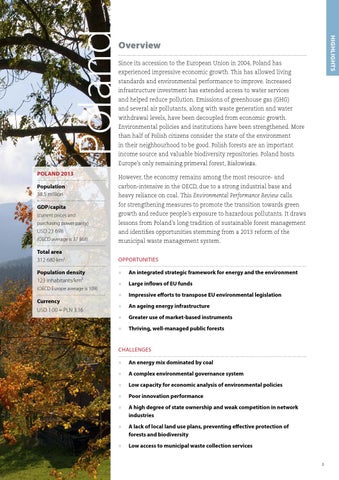Poland
Highlights
Overview Since its accession to the European Union in 2004, Poland has experienced impressive economic growth. This has allowed living standards and environmental performance to improve. Increased infrastructure investment has extended access to water services and helped reduce pollution. Emissions of greenhouse gas (GHG) and several air pollutants, along with waste generation and water withdrawal levels, have been decoupled from economic growth. Environmental policies and institutions have been strengthened. More than half of Polish citizens consider the state of the environment in their neighbourhood to be good. Polish forests are an important income source and valuable biodiversity repositories. Poland hosts Europe’s only remaining primeval forest, Białowieża.
poland 2013
However, the economy remains among the most resource- and
Population 38.5 million
carbon-intensive in the OECD, due to a strong industrial base and
GDP/capita
for strengthening measures to promote the transition towards green
(current prices and
growth and reduce people’s exposure to hazardous pollutants. It draws
purchasing power parity)
lessons from Poland’s long tradition of sustainable forest management
USD 23 698
and identifies opportunities stemming from a 2013 reform of the
(OECD average is 37 868)
municipal waste management system.
Total area 312 680 km2
opportunities
Population density 123 inhabitants/km² (OECD Europe average is 109)
Currency USD 1.00 = PLN 3.16
heavy reliance on coal. This Environmental Performance Review calls
zz
An integrated strategic framework for energy and the environment
zz
Large inflows of EU funds
zz
Impressive efforts to transpose EU environmental legislation
zz
An ageing energy infrastructure
zz
Greater use of market-based instruments
zz
Thriving, well-managed public forests
Challenges zz
An energy mix dominated by coal
zz
A complex environmental governance system
zz
Low capacity for economic analysis of environmental policies
zz
Poor innovation performance
zz
A high degree of state ownership and weak competition in network industries
zz
A lack of local land use plans, preventing effective protection of forests and biodiversity
zz
Low access to municipal waste collection services 3
